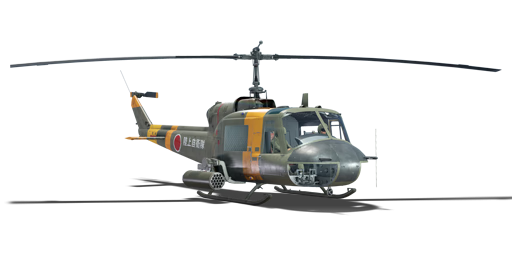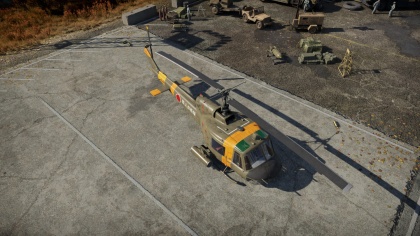Difference between revisions of "UH-1B (Japan)"
m (→Pros and cons: added a con.) (Tag: Visual edit) |
(→Survivability and armour) |
||
| Line 30: | Line 30: | ||
=== Survivability and armour === | === Survivability and armour === | ||
<!-- ''Examine the survivability of the helicopter. Note how vulnerable the structure is and how secure the pilot is, whether the fuel tanks are armoured, etc. Describe the armour, if there is any, and also mention the vulnerability of other critical systems.'' --> | <!-- ''Examine the survivability of the helicopter. Note how vulnerable the structure is and how secure the pilot is, whether the fuel tanks are armoured, etc. Describe the armour, if there is any, and also mention the vulnerability of other critical systems.'' --> | ||
| − | '' | + | Helicopters have a unique role on the battlefield and fitting them with armour is not as easy as it is on a tank or on a jet. The helicopter's setup is such that it must take off and land vertically, hover and fly and as the aircraft gets heavier, bigger and heavier equipment are needed to balance until you are left with a massive helicopter which cannot fly or do its intended mission. The Huey balances this out with a vehicle which can manoeuvre as needed and carry a decent payload whether people or weapon systems. |
| + | |||
| + | The UH-1B does not fly with any protective armour or bullet-proof glass, which if installed would decrease the UH-1's ability to complete its mission. As such, the pilot must take this into account and fly the helicopter accordingly. Bull rushing right into the middle of a battlefield usually ends with disastrous results as the without armour, the Huey has nothing but thin metal fuselage coverings to protect the crew and vital equipment. The engine, transmission, main rotor and tail rotors are all exposed to fire from missiles, rockets, cannons and even small calibre machine guns. The pilot must be aware of their surrounds and work to fight from the enemy vehicles blind spots or weak sides, because a burning and crashed helicopter only pads the enemies' score-count. Pick and choose your battles to preserve the helicopter. | ||
| + | |||
| + | But the "thin metal fuselage" is still "metal", it would provide minor, temporary protection for the interior modules (i.e. fuel, transmission, engine, crew, etc). This means that calibres that are 7.62 mm and below could potentially be stopped by the fuselage for a few several hundred shots until the fuselage starts giving warning when it slowly becomes yellow or orange. | ||
== Armaments == | == Armaments == | ||
Revision as of 00:20, 28 May 2020
Contents
Description
The ▅UH-1B Hiyodori is a rank V Japanese utility helicopter
with a battle rating of 8.3 (AB), 7.7 (RB), and 8.0 (SB). It was introduced in Update "Starfighters".
General info
Flight performance
Describe how the helicopter behaves in the air. Speed, manoeuvrability, acceleration and allowable loads - these are the most important characteristics of the vehicle.
| Characteristics | Max Speed (km/h at 0 m - at sea level) |
Max altitude (metres) | |
|---|---|---|---|
| AB | RB | ||
| Stock | ___ | ___ | _,___ |
| Upgraded | ___ | ___ | |
Survivability and armour
Helicopters have a unique role on the battlefield and fitting them with armour is not as easy as it is on a tank or on a jet. The helicopter's setup is such that it must take off and land vertically, hover and fly and as the aircraft gets heavier, bigger and heavier equipment are needed to balance until you are left with a massive helicopter which cannot fly or do its intended mission. The Huey balances this out with a vehicle which can manoeuvre as needed and carry a decent payload whether people or weapon systems.
The UH-1B does not fly with any protective armour or bullet-proof glass, which if installed would decrease the UH-1's ability to complete its mission. As such, the pilot must take this into account and fly the helicopter accordingly. Bull rushing right into the middle of a battlefield usually ends with disastrous results as the without armour, the Huey has nothing but thin metal fuselage coverings to protect the crew and vital equipment. The engine, transmission, main rotor and tail rotors are all exposed to fire from missiles, rockets, cannons and even small calibre machine guns. The pilot must be aware of their surrounds and work to fight from the enemy vehicles blind spots or weak sides, because a burning and crashed helicopter only pads the enemies' score-count. Pick and choose your battles to preserve the helicopter.
But the "thin metal fuselage" is still "metal", it would provide minor, temporary protection for the interior modules (i.e. fuel, transmission, engine, crew, etc). This means that calibres that are 7.62 mm and below could potentially be stopped by the fuselage for a few several hundred shots until the fuselage starts giving warning when it slowly becomes yellow or orange.
Armaments
Offensive armament
Describe the offensive armament of the helicopter, if any. Describe how effective the cannons and machine guns are in battle, also what ammunition belts or drums are better to use. If there is no offensive weaponry, delete this subsection.
Suspended armament
Describe the helicopter's suspended armament: additional cannons under the winglets, any bombs, and rockets. Since any helicopter is essentially only a platform for suspended weaponry, this section is significant and deserves your special attention. If there is no suspended weaponry remove this subsection.
Usage in battles
Describe the tactics of playing in a helicopter, the features of using the helicopter in a team and advice on tactics. Refrain from creating a "guide" - do not impose a single point of view, but instead, give the reader food for thought. Examine the most dangerous enemies and give recommendations on fighting them. If necessary, note the specifics of the game in different modes (AB, RB, SB).
Modules
| Tier | Flight performance | Survivability | Weaponry | ||
|---|---|---|---|---|---|
| I | |||||
| II | |||||
| III | |||||
| IV | |||||
Pros and cons
Summarise and briefly evaluate the vehicle in terms of its characteristics and combat effectiveness. Mark its pros and cons in the bulleted list. Try not to use more than 6 points for each of the characteristics. Avoid using categorical definitions such as "bad", "good" and the like - use substitutions with softer forms such as "inadequate" and "effective".
Pros:
Cons:
• Can only carry rockets as weaponry.
History
Describe the history of the creation and combat usage of the helicopter in more detail than in the introduction. If the historical reference turns out to be too long, take it to a separate article, taking a link to the article about the vehicle and adding a block "/History" (example: https://wiki.warthunder.com/(Vehicle-name)/History) and add a link to it here using the main template. Be sure to reference text and sources by using <ref></ref>, as well as adding them at the end of the article with <references />. This section may also include the vehicle's dev blog entry (if applicable) and the in-game encyclopedia description (under === In-game description ===, also if applicable).
Media
Excellent additions to the article would be video guides, screenshots from the game, and photos.
See also
Links to the articles on the War Thunder Wiki that you think will be useful for the reader, for example:
- reference to the series of the helicopter;
- links to approximate analogues of other nations and research trees.
External links
Paste links to sources and external resources, such as:
- topic on the official game forum;
- encyclopedia page on the helicopter;
- other literature.
| Fuji Heavy Industries, Ltd. (富士重工業株式会社) | |
|---|---|
| Utility | UH-1B Hiyodori* |
| Attack | ▅AH-1E* · AH-1S* · AH-1S Kisarazu* |
| AH-64DJP* | |
| *Licensed | |
| Fuji Heavy Industries traces its roots to the Nakajima Aircraft Company. At the end of World War II, Nakajima was broken up by the Allied Occupation government, and by 1957 part of the separated company was already known as Fuji Heavy Industries.
Fuji Heavy Industries was renamed to Subaru Corporation from 2017 onward. | |
| See also | Nakajima Aircraft Company (1918-1945) · Bell Aircraft Corporation · Boeing Aircraft |
| Japan helicopters | |
|---|---|
| Utility | ▅UH-1B |
| Attack | ▅AH-1E · AH-1S · AH-1S Kisarazu |
| AH-64DJP | |





